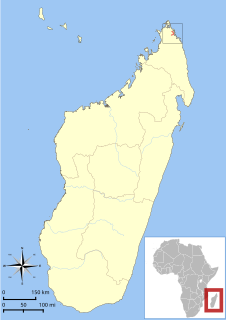
Lemuridae is a family of strepsirrhine primates native to Madagascar and the Comoros Islands. They are represented by the Lemuriformes in Madagascar with one of the highest concentration of the lemurs. One of five families commonly known as lemurs. These animals were once thought to be the evolutionary predecessors of monkeys and apes, but this is no longer considered correct.

Lemurs are mammals of the order Primates, divided into 8 families and consisting of 15 genera and around 100 existing species. They are native only to the island of Madagascar. Most existing lemurs are small, have a pointed snout, large eyes, and a long tail. They chiefly live in trees (arboreal), and are active at night (nocturnal).

The ring-tailed lemur is a large strepsirrhine primate and the most recognized lemur due to its long, black and white ringed tail. It belongs to Lemuridae, one of five lemur families, and is the only member of the Lemur genus. Like all lemurs it is endemic to the island of Madagascar. Known locally in Malagasy as maky or hira, it inhabits gallery forests to spiny scrub in the southern regions of the island. It is omnivorous and the most terrestrial of extant lemurs. The animal is diurnal, being active exclusively in daylight hours.

The ruffed lemurs of the genus Varecia are strepsirrhine primates and the largest extant lemurs within the family Lemuridae. Like all living lemurs, they are found only on the island of Madagascar. Formerly considered to be a monotypic genus, two species are now recognized: the black-and-white ruffed lemur, with its three subspecies, and the red ruffed lemur.

Alluaudia is a genus of flowering plants in the family Didiereaceae. There are six species, all endemic to Madagascar.

The Madagascar spiny forests is an ecoregion in the southwest of Madagascar. The vegetation type is found on poor substrates with low, erratic winter rainfall. The ecoregion contains an outstanding proportion of endemic plant species and is part of the Global 200.

The Madagascar dry deciduous forests represent a tropical dry forest ecoregion situated in the western and northern part of Madagascar. The area has high numbers of endemic plant and animal species but has suffered large-scale clearance for agriculture. They are among the world's richest and most distinctive dry forests and included in the Global 200 ecoregions by the World Wide Fund. The area is also home to distinctive limestone karst formations known as tsingy, including the World Heritage Site of Bemaraha.
Alison Jolly was a primatologist, known for her studies of lemur biology. She wrote several books for both popular and scientific audiences and conducted extensive fieldwork on Lemurs in Madagascar, primarily at the Berenty Reserve, a small private reserve of gallery forest set in the semi-arid spiny desert area in the far south of Madagascar.

Berenty Reserve is a small private reserve of gallery forest along the Mandrare River, set in the semi-arid spiny forest ecoregion of the far south of Madagascar. For more than three decades the late primatologist Alison Jolly, other researchers and students have visited Berenty to conduct fieldwork on lemurs. The reserve is also a favourite for visitors who want to see some of Madagascar's endemic bird species, which include owls and couas.

Isalo National Park is a National Park in the Ihorombe Region of Madagascar, in the southwestern corner of the Province of Fianarantsoa. The closest town is Ranohira, and the closest cities are Toliara and Ihosy. It is a sandstone landscape that has been dissected by wind and water erosion into rocky outcrops, plateaus, extensive plains and up to 200 m deep canyons. There are permanent rivers and streams as well as many seasonal watercourses. Elevation varies between 510 and 1268 m.

The composition of Madagascar's wildlife reflects the fact that the island has been isolated for about 88 million years. The prehistoric breakup of the supercontinent Gondwana separated the Madagascar-Antarctica-India landmass from the Africa-South America landmass around 135 million years ago. Madagascar later split from India about 88 million years ago, allowing plants and animals on the island to evolve in relative isolation.

The common brown lemur is a species of lemur in the family Lemuridae. It is found in Madagascar and Mayotte.

The northern sportive lemur, also known as the Sahafary sportive lemur or northern weasel lemur, is a species of lemur in the family Lepilemuridae. It is endemic to Madagascar. As a result of severe ecological and human pressures, the lemur is classified as Critically Endangered (CR) by the IUCN Red List, and is one of the world's most endangered primate species.
Ringtail, ring tail, or ring-tail may refer to:

The collared brown lemur, also known as the red-collared brown lemur or red-collared lemur, is a medium-sized strepsirrhine primate and one of twelve species of brown lemur in the family Lemuridae. It is only found in south-eastern Madagascar. Like most species of lemur, it is arboreal, moving quadrupedally and occasionally leaping from tree to tree. Like other brown lemurs, this species is cathemeral, lives in social groups, primarily eats fruit, exhibits sexual dichromatism, and does not demonstrate female dominance. The species is listed as Endangered by the International Union for Conservation of Nature (IUCN) and is threatened primarily by habitat loss.

Tsimanampetsotsa National Park also spelt Tsimanampetsotse, and known as Tsimanampetsotsa Nature Reserve is a 432 km2 national park on the south-west coast of Madagascar in the region Atsimo-Andrefana. The park is 90 kilometres (56 mi) south of Toliara and 950 kilometres (590 mi) south of the capital, Antananarivo. Route Nationales (RN) 10 to Faux Cap passes the park and the nearest airport is at Toliara. The national park contains and is named after Lake Tsimanampetsotsa.

The Mikea Forest is a forested region of southwestern Madagascar, between Manombo and Morombe. More specifically, it stretches from Route Nationale 9 to the west coast and from Mangoky south to the Manombo River. It lies at the transition between dry deciduous forest, which is more common further north in Madagascar, and spiny forest, which is dominant in southwestern Madagascar. Its underlying geology is unconsolidated sand, and the region contains several freshwater lakes. The Forêt des Mikea is one of the largest remaining continuous forest blocks in western and southern Madagascar, but it is not protected and it is threatened by human development.

Lemurs' Park is a small botanical garden and lemur reserve covering 5 ha, and is located 22 km (14 mi) southwest of Antananarivo, Madagascar. It was founded around 2000 by Laurent Amouric and Maxime Allorge. Most of its nine lemur species are free-ranging within the park, which also contains more than 70 of Madagascar's endemic plant species. The park is open to the public, offering guided tours as well as standard amenities, a gift shop, and a restaurant. Visitors can arrange transportation between downtown Antananarivo and Lemurs' Park on a private park shuttle.

The Anja Community Reserve is a woodland area and freshwater lake, situated at the base a large cliff. Much of the reserve is dominated by fallen rocks and boulders and there are two small caves providing habitat for bats and owls. This reserve has much sheltered habitat in the pocket of forest that has established between the vast boulders.
















